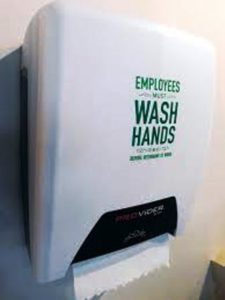Wisconsin Plastics Inc. leaders say they have made a better hand towel dispenser, marking WPI’s first proprietary product.
Designers at the injection molder focused on washroom attendants — whose job it is to refill them — and on customers who want a customized logo.
WPI was already doing contract manufacturing for the bathroom dispenser market, said Mike Kilgore, vice president of marketing and sales. He said WPI still does that.
“We can make the products and ship to our customers’ customers,” he said.
Kilgore said the company’s location is a big part of the connection to the hand towel dispenser market.
“We have most of the major paper manufacturers within an hour of Green Bay,” he said.
That gives the molder a natural connection to the industry, and supplies a good talent pool of people with product design knowledge, he said. WPI’s team of designers has a long history of manufacturing the dispensers for others.
“Wisconsin Plastics has a significant product design department in house where we can help customers if they have a napkin sketch, all the way through design and production,” said Kilgore, a 17-year WPI veteran who himself worked in product design and development before taking the sales and marketing post.
WPI began developing the PROvider in 2015, and launched the product last October.
The line includes mechanical “hands-free” hand towel dispensers, center-pull dispensers and multi-fold dispensers, as well as toilet paper dispensers, known as “bath tissues” in the trade.
“What we’ve done for the research is to secure dispensing systems from some of the major companies in this market,” Kilgore said. The WPI team studied them.
But designing the PROvider was much more involved than just taking apart competing products. It’s like how automakers buy other brands of cars and dismantle them — there’s much more than that to designing a new product.
Now I’m not saying that hand towel dispensers are a life-and-death matter, like when your car brakes fail, or the air bag spews metal fragments into your body. But there are similarities!
You use both nearly every day. How many times have you gone into a public bathroom and found the dispenser empty? Maybe there’s a loose roll sitting on top of it, directly touched by the hands of every single nasty hand that used the restroom that day?
So yes — as every manufacturer now says — quality is a given.
But somebody on the housekeeping crew has to refill them. So WPI talked to these attendants.
The attendants said that many hand towel dispensers were difficult to load and just were not very reliable, especially during times of heavy use, he said.
They need an indicator to easily see how much product is left. Done. Easy to load. Done. And on the end user side — meaning you and me — the designers were looking at how we “interface” with the product. “What are their tendencies.
Is it easy to use? Is it reliable? Is it dependable? Will it give you product every time?” Kilgore said.
WPI went to work. Kilgore said: “We did not want to just do another me-too dispensing system, so we wanted to bring some new developments to the market.”
Those features included a customizable logo and message with a new technology to print directly onto the plastic housing, a four-color print.
The direct-to-ubstrate printing technique places ink directly onto the plastic parts to create a durable, high-quality color image, “which typically for this type of products in this market, you’re not going to see that,” he said.
Buyers of PROvider also can get their own message printed on the dispenser. You know that note taped to the wall in restaurants and grocery stores that says “Employees Must Wash Hands”?
“We’re making that segment a little more elegant,” Kilgore said.
If a company wants its own logo, WPI will remove its logo and put the customized one on instead.
“It’s more realistic. It’s your brand,” he said.
Brail on the dispensers help the visually impaired.
Kilgore said WPI holds three patents on the PROvider, and is looking to get a fourth. The company set up a dedicated website to market the line: www.providerdispensers.com.
Wisconsin Plastics employs 250 people and runs 40 injection molding machines, in clamping forces from 60-1,000 tons.
Kilgore said WPI’s design and manufacturing expertise gives it an advantage in the world of custom injection molding, as does complete assembly.
The company purchases the metal parts used in the dispensers and other products. A toolroom does preventive maintenance.
“We can take a product like this and move it forward pretty quickly,” he said.
WPI began in 1972, when James Christensen created Valley Plating, a metal fabrication company. Ten years later, he added injection molding, and created the WPI division.
As demand for molding grew, the company built its design capabilities.
The founder has retired, but he still comes in every day. Now his sons handle day-to-day activities: the WPI president, also named James Christensen, and John Christensen, the vice president of operations.
Kilgore reports that the PROvider is doing well in the market. “The dispensers that we’ve placed, we’ve had really good feedback,” he said.




